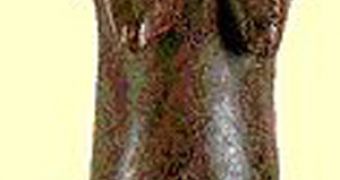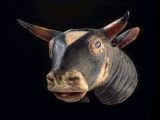The Bissagos Islands, located off the shore of Guinea Bissau (western Africa), are made of 5 main islands: Orango, Formossa, Caravela, Roxa and Boloma. The islands have shallow, sandy beaches that impede the access of medium-sized or high ships. The islands have forests and swamps, and mangroves install on many coasts.
The indigenous population of the archipelago is made of Bidyogo, a matriarchal society. Yellow fever and other diseases brought by Europeans impacted deeply the population of the islands, but the Bidyogo still preserve some rites and dances, mimicking the animals considered to be totems of their various tribes. The dances are some kind of a mime in which the dancers, with the heads covered by wooden masks, mimicking a bull head, adorned with real horns, bronze bells and raffia bundles, imitate the movements of the bull, like the pull up and the horn blows of the animal, while chasing the other dancers, usually women. The rhythm of the dance is marked by large drums and bronze bells fixed to a stick hoisted by another dancer. Other dances may mimic the movements of the hippopotamus, the saw fish or of the cock, the dancers using masks representing these animals.
The Bidyogo villages are located in forest clearings. The houses have a circular floor and conic roof. The walls are made of adobe and covered by lime, painted with stylized life scenes. The interior of the house has a double wall, located at a distance of 1.5 m (5 ft) from the external wall, resulting a cooling circular corridor, shielded from the hot sun rays and the dense tropical rains, in which most of the daily activities take place. Here food is cooked, children play, old men rest or dogs romp. During the night, the family sleeps in the inner enclosure, while animals (chickens, pigs, dogs) sleep on the corridor.
The inner room preserves the most important goods of the family and has a shrine dedicated to the forebears. The shrine has several wooden figurines. One of them represents the protector spirit or totem of the village; the others represent the forebears of the owner of the house. Daily, offerings are made to these figurines: a small amount of palm oil or wine is spilled over them; also, a small amount of food is put in front of them. The offerings are made to gain the good will of the spirits of the forebears, which will protect the family through the totem of the tribe.
The chief of the village has a totemic statue endowed with major magic powers; besides, he is the priest of the village and his offerings are considered the most efficient. In other times, at each 4-5 days a pig would be slaughtered in front of the totem and a large amount of rice, millet and palm wine was offered to it.
The Bidyogo villages also have constructions resembling a large cubic bottle raised on posts: they are silos preserving the cereals from rodents and birds.
Bidyogo belong to the Sudanese type of the Black African race. They are tall, with very dark skin and marked prognathism (the lower jaw sticks out of the upper jaw); the nose is large and the lips very thick.
These people are farmers: they plow their plots in the middle of the forest, cultivating millet, oil palms and especially rice. They are skilled fishermen and, during the high tide, they close the coves and bays with palisades that impede the exit of the fish during the low tide. The waters around the Bissagos archipelago abound in sharks, manta rays and saw fish. The spur of the saw fish was used as amulet against all kind of harms.
Canoes made of tree trunks were used for displacements from one island to another and for trade. Bidyogo made canoe races, and the largest and most beautiful canoe was a reason to take pride in. The prow was decorated with wooden heads of totem mammals (bulls and hippopotamuses). The paddles were beautifully decorated as well. Before a race, the crew hung all kind of amulets on the mask of the prow, which was smeared with palm oil, and symbolically fed it. The crew was made of about 20 rowers and a steersman that headed the bull. The large canoes were used in other times for war expeditions.
The Bydiogo made ceramics without the potter's wheel. The clay spirals were modeled into pots, smoothed using a wood spatula and cooked on an open oven. Wood craftsmen were skilled in making sophisticated adorned stools, drums and idols.
In Bissagos, the sap of a type of palm tree is left to ferment for achieving an alcoholic beverage. The fresh sap resembles a must. Incisions are made up onto the trunk of the palms (at the place where a leaf was pulled out) and the pouring liquid is collected in a special recipient.
The Bidyogo women made complicated hairdos using clay and palm oil: once smeared, the hair is divided in curls, and each curl is stuck with clay balls. The hair gets a red hue, contrasting woman's dark skin. The only dress of the woman is a short skirt, made of raffia, which is fixed on the waist. Another skirt could be placed on the neck, covering the chest and the back. As adornments, collars made of beads and metal earrings are used.
In other times, the Bidyogo lived in a matriarchal society: the woman was the chief of the family; the chiefs of the villages were women and various islands were ruled by queens. Even today, the woman chooses her husband and declares her choice by placing a rice dish in front of the door of her chosen one; if he accepts, he eats the rice. Men cannot ask for divorce, but when a woman wants to separate from her husband, she just puts all the belongings of her husband at the door of the house. The repudiated husband must take the children with him and is charged with their care and custody.
The Bissagos have a population of hippopotamuses. The tusks were used by the locals as ivory and the tough skin for making shields, impenetrable to javelins and even bullets.
Hunting was practiced by the Bidyogo just for religious or ritual purposes. Usually, captured sacred forest buffaloes (Syncerys caffer nanus) were sacrificed. The animal was beheaded using a machete, and the meat was consumed during the festivities of the village. Hunting was made with spears, bows and arrows and crossbows. Traps and nets were used as well. The nets were dragged by various beaters, disposed between the trees, being hidden in the foliage, so that the animals, especially antelopes, chased by the hunters, precipitate towards them and remain captured there.

 14 DAY TRIAL //
14 DAY TRIAL // 
